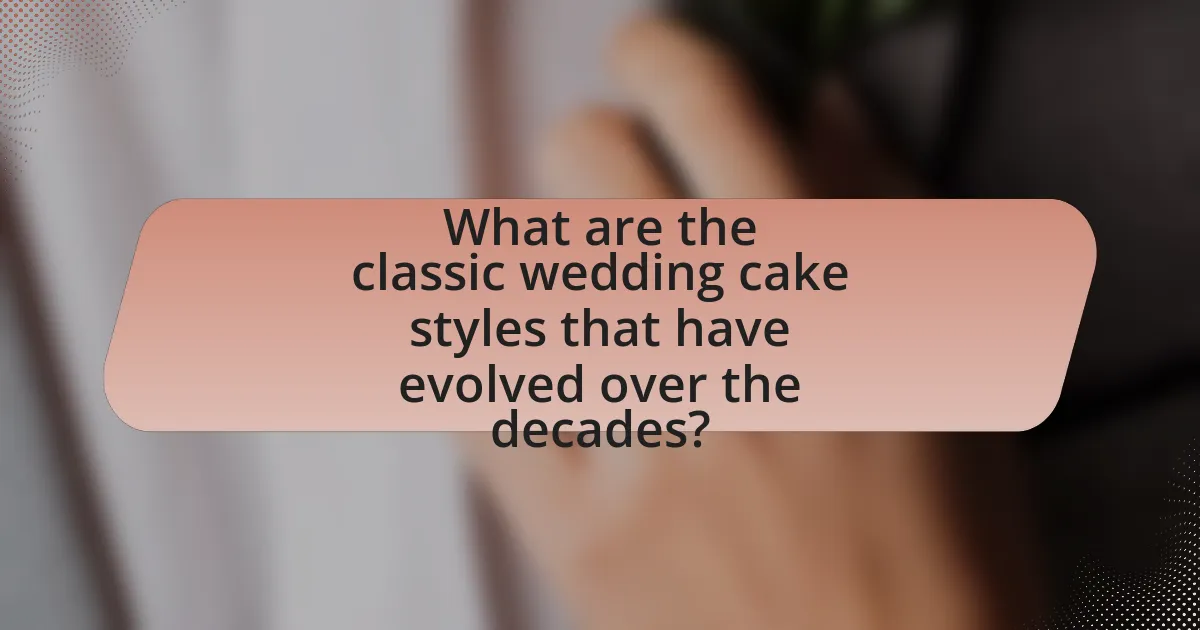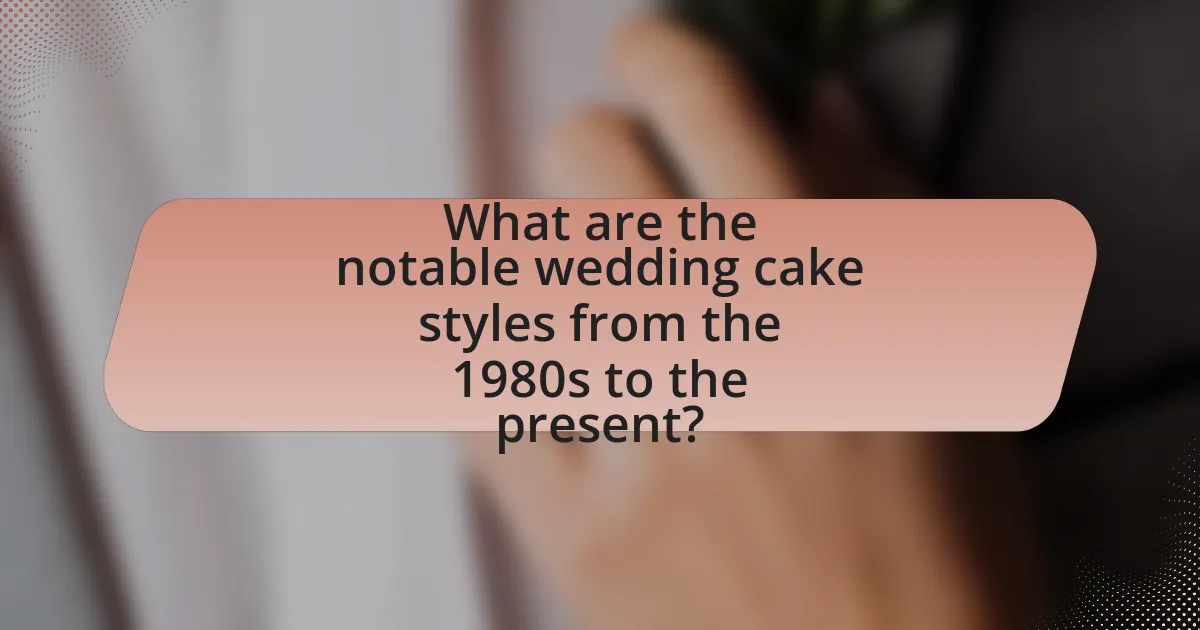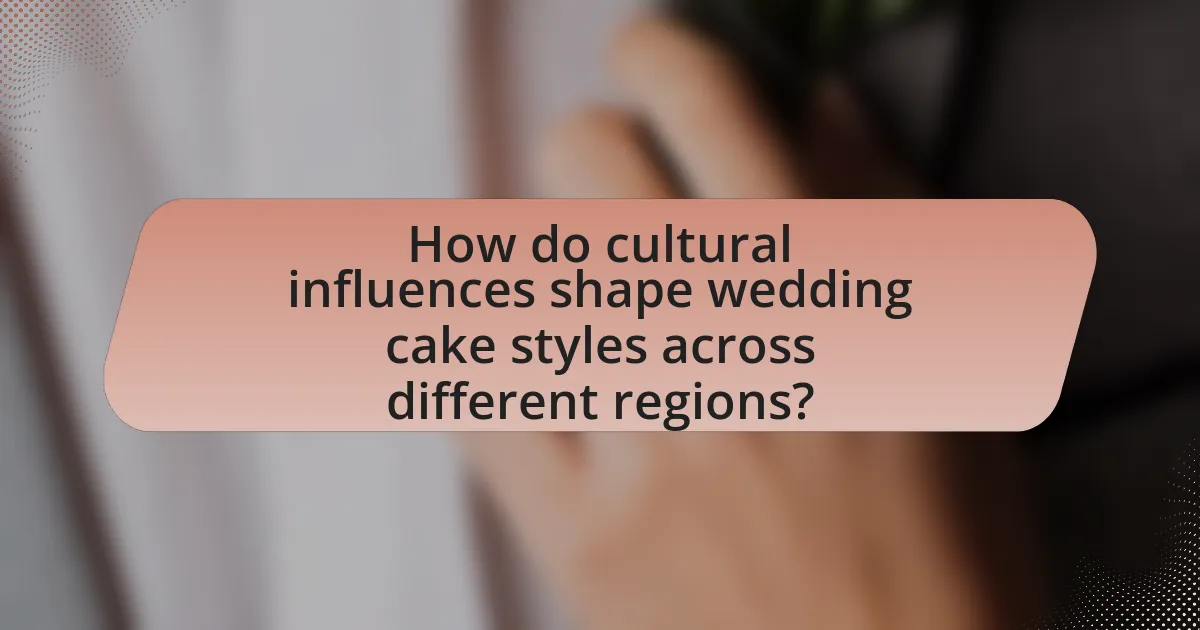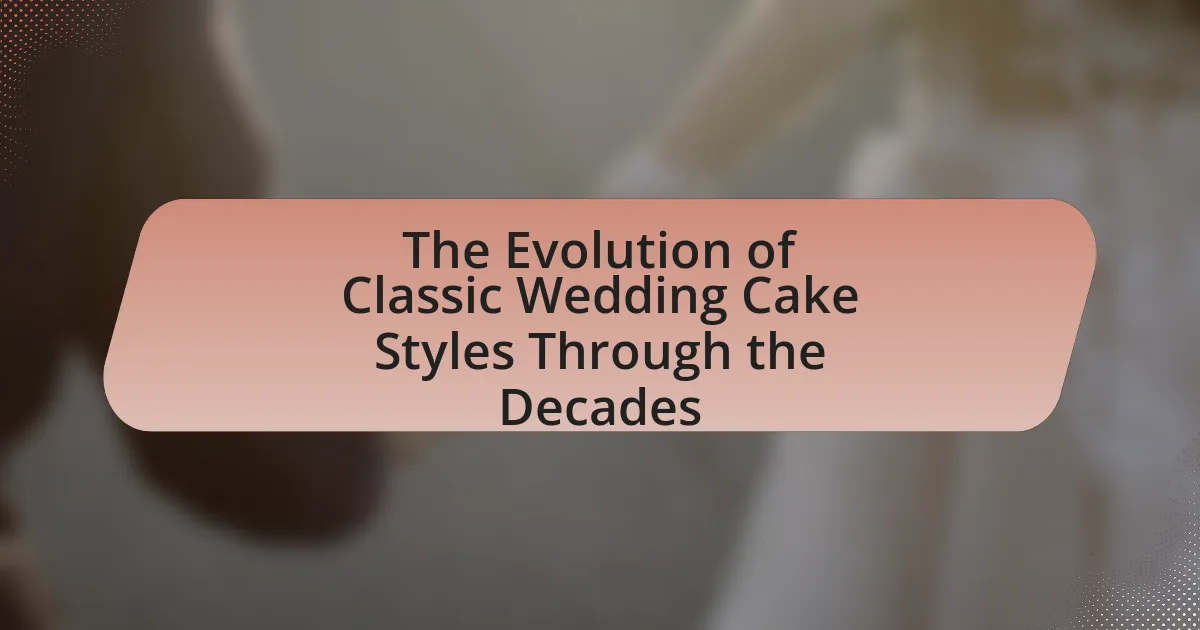The article examines the evolution of classic wedding cake styles from the early 20th century to the present day, highlighting key trends and cultural influences that have shaped these confections. It details the transition from traditional fruitcakes and ornate tiered designs to modern buttercream and fondant cakes, as well as the impact of historical events like the Great Depression and World War II on cake aesthetics. The piece also explores regional variations, popular themes, and customization options that reflect personal stories, culminating in an overview of current trends in wedding cake design and flavor preferences.

What are the classic wedding cake styles that have evolved over the decades?
Classic wedding cake styles that have evolved over the decades include the traditional fruitcake, the tiered cake, and the modern buttercream or fondant cake. The fruitcake, popular in the early 20th century, was often dense and rich, symbolizing prosperity. The tiered cake emerged in the Victorian era, showcasing elaborate designs and multiple layers, reflecting the grandeur of weddings during that time. In recent decades, buttercream and fondant cakes have gained popularity for their versatility in design and flavor, allowing for more creative expressions. These styles illustrate the changing tastes and cultural influences on wedding celebrations throughout history.
How did wedding cake styles change from the 1920s to the 1930s?
Wedding cake styles transitioned from the ornate, multi-tiered designs of the 1920s to simpler, more streamlined forms in the 1930s. In the 1920s, cakes featured elaborate decorations, including intricate sugar flowers and detailed piping, reflecting the opulence of the Jazz Age. By the 1930s, influenced by the Great Depression, couples favored less extravagant cakes, often opting for fewer tiers and minimal decoration, focusing on practicality and affordability. This shift was evident in the use of simpler flavors and frostings, as well as a move towards more modest, yet elegant designs that still maintained a sense of celebration.
What were the key characteristics of wedding cakes in the 1920s?
Wedding cakes in the 1920s were characterized by their multi-tiered designs, elaborate decorations, and the use of fondant for a smooth finish. These cakes often featured intricate sugar flowers, lace patterns, and art deco motifs, reflecting the era’s artistic trends. The popularity of fruitcake as a base was common, but lighter sponge cakes also gained traction, catering to changing tastes. The 1920s marked a shift towards more personalized and extravagant cakes, symbolizing the celebration of love and prosperity during the Roaring Twenties.
How did the Great Depression influence wedding cake designs in the 1930s?
The Great Depression significantly influenced wedding cake designs in the 1930s by promoting simpler, more economical styles. As families faced financial hardships, extravagant multi-tiered cakes became less common, leading to a preference for smaller, single-tier cakes that were more affordable. Additionally, bakers began to use less expensive ingredients and simpler decorations, often opting for minimalistic designs that reflected the era’s emphasis on practicality and frugality. This shift in wedding cake design mirrored broader societal trends during the Great Depression, where resourcefulness and simplicity became essential in various aspects of life, including celebrations.
What trends emerged in wedding cake styles during the 1940s and 1950s?
During the 1940s and 1950s, wedding cake styles prominently featured multi-tiered designs, often adorned with intricate decorations and floral motifs. The use of buttercream frosting became popular, replacing fondant, which allowed for more textured and visually appealing finishes. Additionally, cakes were often topped with figurines representing the bride and groom, reflecting the post-war emphasis on traditional family values and celebrations. The 1950s also saw the introduction of vibrant colors and flavors, moving away from the classic white cake, as couples began to personalize their cakes to reflect their tastes and personalities.
How did World War II impact wedding cake decorations and flavors?
World War II significantly influenced wedding cake decorations and flavors by introducing resource scarcity and a shift in societal norms. During the war, rationing limited the availability of ingredients like sugar, butter, and eggs, leading bakers to adapt by using simpler flavors and less elaborate decorations. Traditional multi-tiered cakes became less common, as couples opted for smaller, more modest cakes that reflected the economic realities of the time. Additionally, the use of alternative ingredients, such as shortening instead of butter, became prevalent, altering the texture and taste of cakes. This period marked a transition towards more practical and accessible wedding cakes, aligning with the wartime ethos of simplicity and resourcefulness.
What were the popular themes for wedding cakes in the 1950s?
Popular themes for wedding cakes in the 1950s included floral designs, tiered structures, and the use of pastel colors. Floral decorations were particularly favored, often featuring roses and other blooms made from icing or sugar. The tiered cake became a symbol of elegance, with multiple layers stacked high, reflecting the post-war desire for celebration and grandeur. Pastel colors, such as soft pinks, blues, and yellows, were commonly used to create a light and romantic aesthetic, aligning with the overall design trends of the era. These themes were influenced by the cultural shifts of the time, including the rise of suburban living and the emphasis on traditional family values.
How did the 1960s and 1970s redefine wedding cake aesthetics?
The 1960s and 1970s redefined wedding cake aesthetics by introducing bold colors, innovative shapes, and a departure from traditional white icing. During this period, cakes began to feature vibrant hues and intricate designs, reflecting the cultural shifts of the time, including the influence of the counterculture movement. Notably, the use of fondant became popular, allowing for smoother finishes and more elaborate decorations. Additionally, the tiered cake design evolved, with some couples opting for unconventional shapes like hexagons or even asymmetrical layers, moving away from the classic round tiers. This transformation in wedding cake aesthetics was further exemplified by the rise of themed weddings, where cakes were customized to reflect personal stories or interests, showcasing a significant shift towards individuality and creativity in wedding celebrations.
What role did cultural movements play in shaping wedding cake styles during this era?
Cultural movements significantly influenced wedding cake styles during this era by reflecting societal values and aesthetics. For instance, the Arts and Crafts movement emphasized handcrafted, natural designs, leading to wedding cakes adorned with organic elements and rustic finishes. Similarly, the rise of the feminist movement in the 1960s and 1970s encouraged more personalized and unconventional cake designs, moving away from traditional white cakes to vibrant colors and unique shapes that represented individual identities. These shifts in wedding cake styles were not merely aesthetic; they symbolized broader changes in cultural attitudes towards marriage and individuality, showcasing how cultural movements directly impacted culinary artistry in wedding celebrations.
How did the introduction of new ingredients affect cake flavors and designs?
The introduction of new ingredients significantly expanded cake flavors and designs by allowing for greater creativity and variety. For instance, the incorporation of ingredients like chocolate, fruit purees, and exotic spices transformed traditional cake recipes, leading to innovative flavor combinations such as chocolate raspberry or cardamom vanilla. Additionally, the availability of new food colorings and fondant enabled bakers to create visually stunning designs, moving beyond the classic white icing to vibrant, multi-colored cakes that reflect personal styles and themes. This evolution is evident in wedding cakes, which have transitioned from simple, tiered structures to elaborate, artistic creations that showcase both flavor and aesthetic appeal.

What are the notable wedding cake styles from the 1980s to the present?
Notable wedding cake styles from the 1980s to the present include the classic tiered cake, the contemporary fondant-covered cake, and the naked cake. In the 1980s, traditional tiered cakes with buttercream frosting and elaborate decorations were popular, often featuring floral designs and intricate piping. The 1990s saw the rise of fondant-covered cakes, which allowed for smoother finishes and more creative designs, including themed cakes that reflected the couple’s personalities. In the 2000s, the naked cake emerged, characterized by its minimal frosting and exposed layers, emphasizing a rustic and organic aesthetic. Each of these styles reflects changing trends in wedding aesthetics and preferences over the decades.
How did the 1980s bring about a shift in wedding cake trends?
The 1980s brought about a significant shift in wedding cake trends by introducing more elaborate designs and diverse flavors. During this decade, couples began to favor multi-tiered cakes adorned with intricate decorations, such as sugar flowers and lace patterns, moving away from the simpler styles of previous decades. This change was influenced by the rise of wedding shows and magazines that showcased extravagant cake designs, leading to a demand for personalization and creativity in wedding cakes. Additionally, the incorporation of non-traditional flavors, such as chocolate and fruit, became popular, reflecting a broader trend towards customization in wedding celebrations.
What were the most popular cake flavors and designs in the 1980s?
In the 1980s, the most popular cake flavors included chocolate, vanilla, and carrot cake, while designs often featured bold colors, geometric shapes, and tiered structures. Chocolate cake was favored for its rich taste, vanilla remained a classic choice, and carrot cake gained popularity for its unique flavor and texture. The design trends of the decade embraced vibrant colors and intricate decorations, often incorporating elements like fresh flowers, airbrushing techniques, and whimsical themes, reflecting the era’s overall aesthetic of excess and creativity.
How did the rise of celebrity weddings influence cake styles in the 1980s?
The rise of celebrity weddings in the 1980s significantly influenced cake styles by popularizing extravagant and multi-tiered designs. High-profile weddings, such as those of Prince Charles and Lady Diana Spencer in 1981, showcased elaborate cakes that featured intricate decorations, fondant icing, and bold flavors, setting new standards for wedding cakes. This trend led to an increase in demand for custom cakes that reflected the grandeur and opulence seen in celebrity events, prompting bakers to innovate with unique shapes, colors, and embellishments, including fresh flowers and edible gold. As a result, the 1980s became a decade marked by a shift towards more personalized and visually striking wedding cakes, driven by the influence of celebrity culture.
What innovations in wedding cake design emerged in the 1990s and 2000s?
Innovations in wedding cake design during the 1990s and 2000s included the introduction of fondant as a primary decorating medium, which allowed for smoother finishes and more intricate designs. This period also saw the rise of themed cakes, where couples personalized their cakes to reflect their interests or wedding themes, leading to unique shapes and designs. Additionally, the use of edible images and advanced airbrushing techniques became popular, enabling detailed and colorful decorations that were previously difficult to achieve. These innovations transformed wedding cakes from traditional multi-tiered confections into personalized works of art, catering to diverse tastes and styles.
How did technology change the way wedding cakes were decorated?
Technology significantly transformed wedding cake decoration by introducing advanced tools and techniques that enhanced creativity and precision. Innovations such as airbrushes allowed for intricate designs and color gradients, while edible printers enabled the reproduction of detailed images and patterns directly onto cake surfaces. Additionally, the development of fondant and modeling chocolate provided decorators with versatile materials that could be shaped and molded into elaborate decorations, surpassing traditional buttercream techniques. These advancements have led to more personalized and visually stunning wedding cakes, reflecting individual tastes and themes more effectively than ever before.
What new flavor combinations became popular during this time?
During this time, popular new flavor combinations included lemon and lavender, chocolate and raspberry, and vanilla with salted caramel. These combinations emerged as couples sought to personalize their wedding cakes, moving away from traditional flavors. The rise of artisanal baking and the influence of culinary trends contributed to the popularity of these unique pairings, reflecting a broader shift towards innovative and sophisticated flavor profiles in wedding desserts.
What are the current trends in wedding cake styles today?
Current trends in wedding cake styles today include minimalist designs, bold colors, and unique flavor combinations. Minimalist cakes often feature clean lines and simple decorations, reflecting a modern aesthetic that prioritizes elegance over extravagance. Bold colors, such as deep blues, rich greens, and vibrant florals, are increasingly popular, allowing couples to express their personalities and wedding themes. Additionally, unique flavor combinations, such as lavender lemon or chocolate raspberry, are gaining traction, moving away from traditional vanilla and chocolate options. These trends are supported by data from wedding industry reports, which indicate a shift towards personalization and creativity in wedding planning.
How are modern wedding cakes reflecting personal styles and themes?
Modern wedding cakes reflect personal styles and themes through customization and unique design elements. Couples increasingly choose flavors, colors, and decorations that resonate with their individual tastes and wedding themes, moving away from traditional white cakes. For instance, the rise of non-traditional flavors like red velvet or chocolate, along with personalized decorations such as monograms or themed figurines, showcases the couple’s identity. Additionally, trends like naked cakes or geometric designs illustrate a shift towards minimalism and modern aesthetics, aligning with contemporary wedding themes. This evolution is supported by industry data indicating that 70% of couples now opt for custom designs that reflect their personalities, demonstrating a clear departure from conventional wedding cake norms.
What sustainable practices are being adopted in wedding cake production?
Sustainable practices in wedding cake production include the use of organic ingredients, local sourcing, and eco-friendly packaging. Organic ingredients reduce chemical usage and promote biodiversity, while local sourcing minimizes transportation emissions and supports local economies. Eco-friendly packaging, such as biodegradable or recyclable materials, further reduces environmental impact. These practices are increasingly adopted by bakers to align with consumer demand for sustainability in food production.

How do cultural influences shape wedding cake styles across different regions?
Cultural influences significantly shape wedding cake styles across different regions by dictating ingredients, designs, and traditions associated with weddings. For instance, in Western cultures, multi-tiered cakes adorned with fondant and intricate decorations symbolize prosperity and celebration, while in Italy, the traditional “millefoglie” cake, made of layers of puff pastry and cream, reflects local culinary preferences. Additionally, in many Asian cultures, cakes often incorporate rice flour and are designed to be shared among guests, emphasizing community and togetherness. Historical practices, such as the use of fruitcake in British weddings, further illustrate how regional customs and available resources influence cake styles, showcasing a blend of local flavors and cultural significance.
What are the unique wedding cake traditions in various cultures?
Unique wedding cake traditions vary significantly across cultures. In Italy, the “Torta Nuziale” is often a multi-tiered cake adorned with fresh flowers, symbolizing fertility and prosperity. In Mexico, the “Pastel de Tres Leches” is popular, a moist cake soaked in three types of milk, representing the blending of families. In Japan, a traditional wedding cake called “Shirozukuri” is made from rice flour and is often decorated with seasonal fruits, symbolizing purity and harmony. In Greece, the “Koufeta,” sugar-coated almonds, are often placed on top of the wedding cake, symbolizing fertility and the couple’s sweet life together. Each of these traditions reflects cultural values and beliefs surrounding marriage, showcasing the diversity in wedding celebrations globally.
How do regional ingredients influence wedding cake flavors?
Regional ingredients significantly influence wedding cake flavors by incorporating local tastes and traditions into the recipes. For example, in the Southern United States, wedding cakes often feature flavors like pecan, peach, or coconut, reflecting the region’s agricultural products. In contrast, New England wedding cakes may include spices like cinnamon and nutmeg, which are historically prevalent in the area. This regional variation not only enhances the flavor profile but also connects the cake to the cultural heritage of the area, making it a meaningful part of the celebration.
What are some traditional wedding cake designs from around the world?
Traditional wedding cake designs vary significantly across cultures, reflecting local customs and ingredients. In the United Kingdom, the classic fruitcake is often used, adorned with marzipan and royal icing, symbolizing prosperity and fertility. In Italy, the Millefoglie, a layered pastry filled with cream, is popular, representing the layers of a couple’s life together. In Mexico, the Tres Leches cake, soaked in three types of milk, is a staple, symbolizing sweetness and abundance. In India, multi-tiered cakes decorated with intricate designs and vibrant colors are common, often incorporating flavors like cardamom and saffron, reflecting the rich culinary heritage. Each of these designs not only serves as a dessert but also carries cultural significance, making them integral to wedding celebrations worldwide.
How do modern couples incorporate personal touches into their wedding cakes?
Modern couples incorporate personal touches into their wedding cakes by customizing flavors, designs, and decorations that reflect their unique relationship and shared interests. For instance, couples often choose flavors that hold sentimental value, such as a favorite dessert from their first date or a family recipe. Additionally, they may opt for cake designs that incorporate personal elements like monograms, favorite colors, or themes that represent their hobbies or travels together. This trend is supported by a growing demand for bespoke wedding cakes, with 60% of couples in recent surveys indicating they prefer personalized options over traditional designs.
What are some popular customization options for wedding cakes today?
Popular customization options for wedding cakes today include personalized cake toppers, unique flavor combinations, and intricate designs that reflect the couple’s personality. Personalized cake toppers can feature the couple’s names or likenesses, adding a personal touch. Unique flavor combinations, such as lavender lemon or chocolate raspberry, cater to diverse tastes and preferences. Additionally, intricate designs, including hand-painted details or floral arrangements, enhance the visual appeal and can be tailored to match the wedding theme. These trends reflect a shift towards more individualized and creative expressions in wedding cake design.
How can couples choose a wedding cake that reflects their love story?
Couples can choose a wedding cake that reflects their love story by incorporating personal elements such as flavors, designs, and themes that symbolize their relationship. For instance, selecting flavors that represent significant moments together, like the first dessert shared, can create a meaningful connection. Additionally, couples can choose cake designs that reflect their shared interests or experiences, such as floral patterns that represent their wedding venue or colors that match their wedding theme. Historical trends in wedding cakes, such as the shift from fruitcake to more personalized options in the 20th century, show that customization has become increasingly popular, allowing couples to express their unique narratives through their cake choices.
What tips should couples consider when selecting their wedding cake?
Couples should consider their personal taste, budget, and wedding theme when selecting their wedding cake. Personal taste ensures the cake reflects the couple’s preferences, while budget helps in choosing a cake that is financially feasible. The wedding theme influences the cake’s design, flavor, and overall presentation. Additionally, couples should sample different flavors and consult with a reputable baker to ensure quality and creativity in the cake design. Research indicates that 70% of couples prioritize taste over appearance, highlighting the importance of flavor in the selection process.
How can couples ensure their wedding cake fits their budget?
Couples can ensure their wedding cake fits their budget by setting a clear budget limit before consulting with bakers and prioritizing essential features. Establishing a budget allows couples to communicate their financial constraints effectively, enabling bakers to suggest options that align with their price range. Additionally, couples can consider factors such as cake size, flavor choices, and decoration complexity, as these elements significantly influence cost. For instance, a simple design with fewer tiers typically costs less than an elaborate multi-tiered cake. By researching average cake prices in their area and comparing quotes from multiple bakers, couples can make informed decisions that adhere to their budget while still achieving their desired aesthetic.
What are the best practices for tasting and choosing flavors for a wedding cake?
The best practices for tasting and choosing flavors for a wedding cake include sampling a variety of flavors, considering the season, and incorporating personal preferences. Couples should schedule tastings with their baker to explore different combinations, ensuring they select flavors that complement each other and appeal to their guests. Seasonal ingredients often enhance flavor profiles, making choices like lemon in spring or spiced cakes in fall more appealing. Additionally, personal favorites should be prioritized, as the cake represents the couple’s unique taste. Research indicates that 70% of couples choose flavors based on personal significance, reinforcing the importance of individual preference in the selection process.
